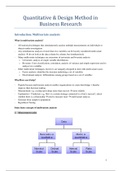Quantitative & Design Method in
Business Research
Introduction: Multivariate analysis
What is multivariate analysis?
- All statistical techniques that simultaneously analyse multiple measurements on individuals or
objects under investigation
- Any simultaneous analysis of more than two variables can be loosely considered multivariate
analysis do not look at the data column by column, but simultaneously
- Many multivariate techniques are extensions of univariate and bivariate analysis:
o Univariate: analysis of single-variable distributions
o Bivariate: Cross-classification, correlation, analysis of variance and simple regression used to
analyse two variables
- Other multivariate techniques, however, are uniquely designed to deal with multivariate issues:
o Factor analysis: identifies the structure underlying a set of variables
o Discriminant analysis: differentiates among groups based on a set of variables
Why/How can it help?
- Popular because multivariate analysis enables organizations to create knowledge + thereby
improve their decision making
- Measurement: e.g. cycling sport drugs more than one test more reliable
- Explanation + Prediction: e.g. How is a certain strategy connected to a firm’s success?; check
whether there is a relationship need to measure more multivariate analysis
- Generate from sample to population
- Hypothesis Testing
Some basic concepts of multivariate analysis
1. Measurement scales
1
,Nonmetric measurement scales:
- Describes differences in type/kind by indicating the presence/absence of a characteristic/property
- Properties are discrete in that by having a particular feature, all other features are excluded e.g. if a
person is male, he cannot be female
- Can be made with either a nominal or an ordinal scale:
a) Nominal:
- Size of the number is not related to the amount of the characteristic being measured numbers as
a way to label/identify subjects/objects, indicating the presence/absence of the
attribute/characteristic under investigation,
- Also known as categorical scales
- Example: (2 for females and 1 for males) with these values, we can only tabulate the number of
males and females, it is nonsensical to calculate an average value of gender
b) Ordinal:
- Larger numbers indicate more/less of the characteristic measured, but not how much more/less
- Variables can be ordered or ranked in relation to the amount of the attribute possessed but only
“greater/less than”
- Example:
o Education primary school, high school, bachelor, master etc.
o Product A has the most satisfaction, followed by product B + then product C. However,
we cannot make any statements on the amount of the differences between products (e.g.
whether the difference between products A and B is greater than the difference between
product B and C) For that, we have to use an interval scale)
Restriction of nonmetric scales
- Cannot perform any arithmetic operations (no sums, averages, multiplication or division etc.)
- For that reason, many multivariate techniques are devised solely to deal with nonmetric data (e.g.
correspondence analysis) or to use nonmetric data as an independent variable (e.g. discriminant
analysis with a nonmetric dependent variable or multivariate analysis of variance with nonmetric
independent variables)
Metric measurement scales
- Used when subjects differ in amount or degree on a particular attribute
- Two different metric measurement scales are interval and ratio – both provide the highest level of
measurement precision, permitting nearly any mathematical operation to be performed, these two
scales have constant units of measurement, so differences between any two adjacent points on any
part of the scale are equal
- Only real difference between internal and ratio scale is that interval scales use an arbitrary zero
point, whereas ratio scales include an absolute zero point
a) Interval contains ordinal properties + there are equal differences between scale points; e.g.
temperature Celsius and Fahrenheit, however not possible to speak in terms of multiples e.g.
80°F is not necessarily twice as hot as 40°F
b) Ratio: contains interval scale properties + natural zero point; e.g. common weighing machines
– have an absolute zero point and can be spoken in terms of multiples when relating one point
on the scale to another e.g. 100 pounds is twice as heavy as 50 pounds; money; time
2
,The impact of choice of measurement scale
1. The researcher must identify the measurement of scale of each variable used, so that nonmetric
data are not incorrectly used as metric data + vice versa. If the researcher incorrectly defines this
measure as metric, then it may be used inappropriately (e.g. finding the mean value of gender)
2. The measurement scale is also critical in determining which multivariate techniques are the most
applicable to the data, with consideration made for both independent and dependent variables. The
metric or nonmetric properties of independent and dependent variables are determining factors in
selecting the appropriate technique.
2. Measurement Error
- Degree to which the observed values are not representative of the “true” values.
- All variables used in multivariate techniques must be assumed to have some degree of
measurement error
- Measurement error distorts observed relationships + makes multivariate techniques less powerful
- In assessing the degree of measurement error present in any measure, the researcher must address
two important characteristics of a measure:
1. Validity: degree to which a measure
accurately represents what it is supposed
to e.g. we want to measure discretionary
income (verfügbares Einkommen), we
should not ask about total household
income starts with thorough
understanding of what is to be measured
+ then making the measurement as
“correct” + accurate as possible
2. Reliability: if validity is assured,
consider the reliability – the observed
variable’s degree of precision
(reproducibility of results) + thus the
lack of random measurement error
Possibilities to reduce measurement error
- Improving individual variables
- Summated scales (also known as multivariate measurements): several variables are joined in a
composite measure to represent a concept e.g. summed rating of product satisfaction (finding the
average score among three measures overall satisfaction, the likelihood to recommend, and the
probability of purchasing again)
- Objective is to avoid the use of only a single variable to represent a concept + instead use several
variables as indicators, all representing differing facets of the concept guiding premise:
multiple responses reflect “true” response more accurately than does a single response
3
, 3. Statistical significance versus statistical power
- All multivariate techniques, except for cluster analysis and perceptual mapping, are based on the
statistical inference of a population’s values or relationships among variables from a randomly
drawn sample of that population
- Researchers are often interested in drawing inferences (Schlussfolgerungen) from a sample.
- Interpreting statistical inferences requires the researcher to specify the acceptable levels of
statistical error that result from using a sample most common approach is Type I error
- Type I error (α) = the probability of rejecting the null hypothesis when it is true
- Type II error (β) = the probability of failing to reject the null hypothesis when it is false
- Power (1-β) = probability of correctly rejecting the null hypothesis when it is false.
a. Although specifying alpha establishes the level of acceptable statistical significance, it is the level
of power that dictates the probability of success in finding the differences if they actually exist.
Why not set both α and β at acceptable levels? Because the Type I and Type II errors are inversely
related. Thus, Type I error becomes more restrictive (more closer to zero) as the probability of a
Type II error increases. That is, reducing Type I errors reduces the power of the statistical test.
Thus, researchers must strike a balance between the level of alpha + the resulting power.
Impacts on Statistical Power
Power is not solely a function of alpha. Power is determined by three factors:
1. Effect size: actual size of the effect a larger effect size is more likely to be found than a smaller
effect + thus more likely to impact the power of the statistical test
2. Alpha (α): As α is set at smaller levels, power decreases. Typically, α = .05.
3. Sample size: Increased sample sizes always produce greater power for the statistical test. As
sample sizes increase, researcher must decide if the power is too high At very large sample
sizes, almost any effect is significant raising the issue of practical significance vs. statistical
significance
4






